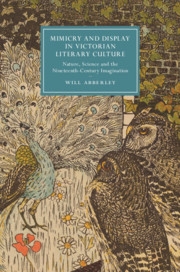 Mimicry and Display in Victorian Literary Culture
Mimicry and Display in Victorian Literary Culture Book contents
- Mimicry and Display in Victorian Literary Culture
- Cambridge Studies in Nineteenth-Century
- Mimicry and Display in Victorian Literary Culture
- Copyright page
- Contents
- Figures
- Acknowledgements
- Introduction
- Chapter 1 Seeing Things
- Chapter 2 Divine Displays
- Chapter 3 Criminal Chameleons
- Chapter 4 Darwin’s Little Ironies
- Chapter 5 Blending in and Standing out, I
- Chapter 6 Blending in and Standing out, II
- Conclusion
- Notes
- Bibliography
- Index
- Cambridge Studies in Nineteenth-Century Literature and Culture
Chapter 6 - Blending in and Standing out, II
Mimicry, Display and Identity Politics in the Literary Activism of Israel Zangwill and Charlotte Perkins Gilman
Published online by Cambridge University Press: 16 May 2020
- Mimicry and Display in Victorian Literary Culture
- Cambridge Studies in Nineteenth-Century
- Mimicry and Display in Victorian Literary Culture
- Copyright page
- Contents
- Figures
- Acknowledgements
- Introduction
- Chapter 1 Seeing Things
- Chapter 2 Divine Displays
- Chapter 3 Criminal Chameleons
- Chapter 4 Darwin’s Little Ironies
- Chapter 5 Blending in and Standing out, I
- Chapter 6 Blending in and Standing out, II
- Conclusion
- Notes
- Bibliography
- Index
- Cambridge Studies in Nineteenth-Century Literature and Culture
Summary
Chapter 6 argues that evolutionary theories of crypsis and display served as models for thinking through the positions of disempowered, marginalised groups at the turn of the century. Israel Zangwill sometimes invoked protective mimicry to decry Jewish assimilation as the degenerate defence mechanism of helpless dependents. Persecution, he complained, had driven Jews to become invisible and, thus, alienated from their own nature. Conversely, Charlotte Perkins Gilman made sense of women’s perceived weakness via the conspicuous display of sexual selection. Gilman argued that women’s eye-catching, impractical clothes reflected their feeble dependence on men. Through their rhetoric of standing out and blending in, both authors sought to recover the imagined authentic essences of their group identities, which regimes of Gentile or male surveillance had repressed. Yet they also imagined this self-realisation being asserted through visual display. The intersubjectivity of display rendered it inherently inauthentic, mediated by arbitrary symbols. This contradiction caused Zangwill’s vision of Jewish self-realisation to vacillate between essentialism and anti-essentialism, between a return to pure origins and progression toward open-ended, heterogeneous identity. Gilman’s vision similarly vacillated between the restoration of a primordial female ‘modesty’ and the progressive transcendence of visible sex distinctions.
- Type
- Chapter
- Information
- Mimicry and Display in Victorian Literary CultureNature, Science and the Nineteenth-Century Imagination, pp. 178 - 204Publisher: Cambridge University PressPrint publication year: 2020
